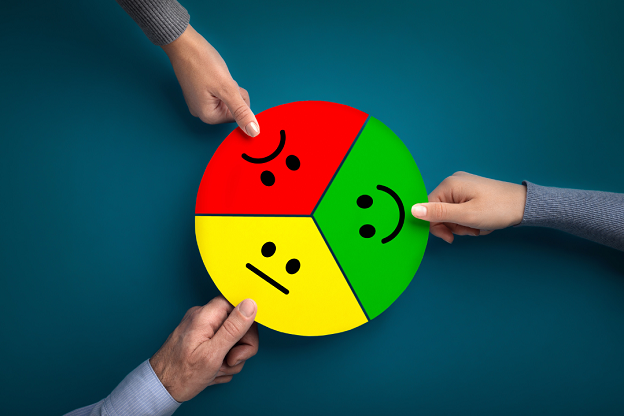How to Give Feedback
Let's talk about the most important "f-word" in education: Feedback.
For example, Mozart has usually been represented as a wunderkind - a complete natural, genius. And although he was a historical example of a child prodigy, he didn't do it on his own. You see, his father was a world-class teacher and musician in his own right. Which means junior was receiving the best education 24 hours a day. And this explains why children can grow up speaking their parents' native tongue without even learning it in school (constant feedback). So today, let's look at:
How Not to Give FeedbackFeedback determines everything. You can be the greatest pianist in the world but if you're not able to give reliable feedback, you're just an artist and not a teacher. Without clear, objective instructions, students won't make any progress. I'm sure you know the feeling well. Think about jobs where they just threw you in with a sink-or-swim approach or teachers who got angry at you because you didn't understand their (confusing) directions. More examples:
And educators will continue making these mistakes until they understand the types of feedback that exist. The Right Way to Give Feedback
According to the book Ultralearning by Scott Young, there are 3 kinds. Outcome feedback is the most available. It's a little better than nothing - because it doesn't really tell you how you're doing or what you're missing. School grades are one example. Does getting an A mean you understand the material? It might mean you're just good at memorizing (or you cheated). Does a D make you a bad student? Maybe you just process the material at a slower (and deeper) level or perhaps the teacher just isn't good. Next, information feedback tells you what you're doing wrong, but not how to fix it. I experienced this on a trip to Barcelona. I made it a point - when I wasn't too shy - to practice the Spanish I'd been studying. Sometimes people would flash a smile of understanding, most times I'd get faces of confusion. Now ... onto the very best form of feedback. Best of The BestCorrective feedback is the crème de la crème. This tells you what you're doing wrong and how to fix it - like a doctor who figures out why you're sick and gives you the correct medicine. This is the biggest reason you should be working with an instructor, because any self directed feedback has a high chance of being unreliable. Though many teachers are biased (everyone's human), at least they're going to have more experience and knowledge than you - a bad teacher is better than no teacher. And when you get better at piano, you can always ditch them and find a better one. Bonus tip: Make sure the feedback you give, or receive, is as immediate as possible. This is the first thing I learned when training my dog. Whatever behavior you're rewarding, you have to give them a treat within a few seconds or they will forget (it's the same for people). This is also what makes piano competition or jury comments useless - you get them almost a week (or more) later when you've forgotten nearly everything about that performance. MethodsNow in terms of corrective feedback, I'm going to share with you the two most useful methods that I use. With verbal or written instructions, you want the student to have a crystal-clear understanding on what to do and how to do it. How do you do this? You check for comprehension. I basically ask them to summarize my instructions ... in their own words. If you don't ask them to do this, they'll just parrot your exact words back to you (thank you public school system). What's trickier is that even if they do this correctly, they still might not get it. For example, I remember the following scenario: Me: Understand what I said? Student: Yes, you asked to (blah blah blah, summary in his own words) M: You sure about that? S: Nods his head M: Are you just saying yes because you're trying to be a good student? S: Nods again So be aware that you may have to dig deeper. Now in terms of actual piano playing, demonstration is the most concrete, objective form of feedback. As a side note, I see many teachers do anything but demonstrate or even ask the student to play. They're like bloated windbags who over-explain and are more interested in the sound of their own voice than helping the student. Rant over (thanks for obliging me). So here's what I do:
When necessary, I will demonstrate (play) how a particular passage sounds. Then I ask them to play it back. And the final step is to play it together (simultaneously). Now if you want to speed up their progress, do more simultaneous playing. However, if you want to improve their comprehension, go back and forth between the first 2 steps more than a few times - or even ask them to play the passage before you demonstrate. Think of it as a camera "focusing." They're not going to nail it after one demonstration - each attempt is the picture becoming "clearer." And to further enhance their understanding, I might not even say anything. I'll just play it again without providing any tips or assistance. Of course if they're having a really difficult time, I'll gladly add in some instructions - such as move your hand to this position when you get to this passage, etc. However, the ultimate goal is for them to understand in the fewest tries possible. This skill is super useful since they'll be on their own (home practice) most of the time. The more they accurately demonstrate what I've played at their lessons, the higher chance of them replicating it at home. ToolsBesides giving effective feedback at the lesson, it's just as important to give them the proper tools to succeed at home (since lessons are only once a week). TrackingThe first one is a journal (instruction booklet) with a checklist that needs to be completed every day. Each checklist item can be whatever you want, such as:
For more advanced students, you can even use the checklist as a scoring system. For example, I can have them pick a number (1-10) for use of proper dynamics, articulation, or how often they used a metronome. Once we have that number, we can work together to slowly increase it. This helps them critically analyze their practice instead of just playing on autopilot. By the way, having an awesome reward system does a lot to motivate them to get their points for that week. VideosNow my most important resource is the library of videos I've recorded for all of their music (pick up a free copy here). Why? Because the tape doesn't lie. As previously mentioned, if you've demonstrated what to practice at the lesson - and if the student can successfully play it back - then the videos become the most accurate, concrete example of feedback they can use (at home). Videos hit all of the senses necessary for piano playing: listening (melody, harmony), physical (rhythm) and visual (which keys). They know exactly what to play, when to play, and how to play it. If they continue to use the videos diligently, many times they'll even show up to the lesson having learned more than what was taught the previous week. Sometimes they'll even learn new pieces entirely on their own! When NOT to Use FeedbackNow there are also times you shouldn't use feedback. For example, not all lessons will be consistent. In statistics, there's a term known as regression to the mean. Basically, it means whether you've had a great or terrible lesson, the next one will be closer to the average. Which means your feedback isn't always directly responsible for your student's results. And sometimes they've had a bad lesson because they've had a tough week (school or life), so make sure you know what's going on in their personal lives outside of piano. Lastly, giving feedback is like a balancing act. As Scott Young says, "Being too successful is as damaging as failing too much." The more you teach, the more you'll experience a mixture of wins and losses. To be human is to be inconsistent, so embrace every success and failure that comes your way. Happy practicing!
Did you enjoy reading this today?
Your donation helps me create free content. Every dollar goes a long way! =)
0 Comments
Leave a Reply. |
Categories
All
|





